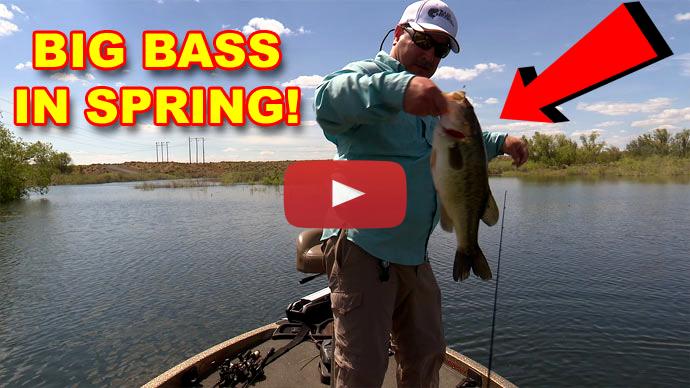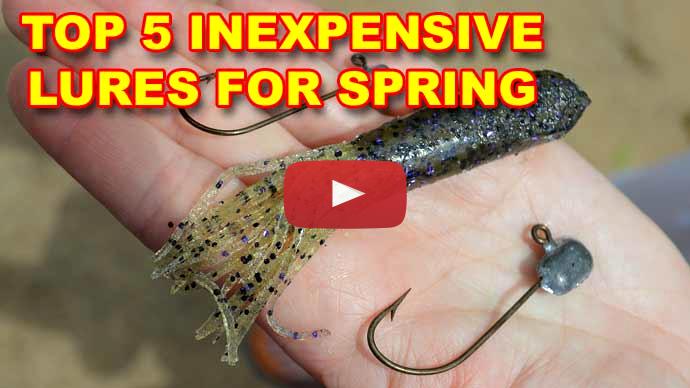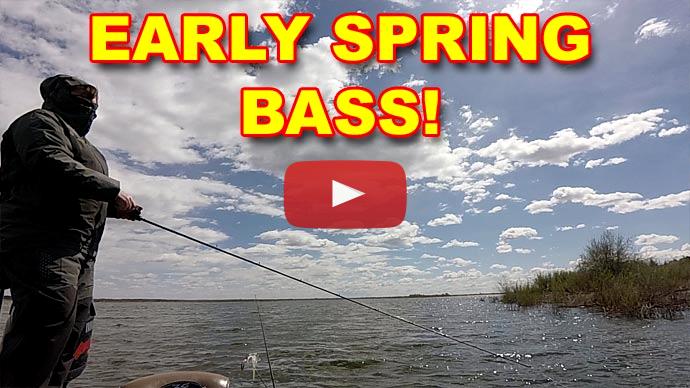Hey, guys, I'm Bassmaster Elite Series Pro Pat Schlapper with bassresource.com. I'm gonna talk about structure fishing in the springtime and kind of how I approach finding fish. So, in the springtime, it's all about the spawn and the migration route that them fish are gonna take from the main lake or wherever they're wintering at as they move up to spawn. So, the first thing I do is I'll look at a map and I'll look for a likely place where those fish might spawn. You know, it could be the back of a cove, it could be a marina, you know, anything that's protected where it has the habitat for them to spawn. So what I look for are secondary primary points leading back into that pocket. And once I find those points, I wanna find the structure that they're most likely to hold on.
And structure fishing is kind of a loose term, you know, it could mean a rock pile, it could mean a single rock. It could mean to me a clump of grass on a flat. It could mean a tree, a log. So every lake and system is a little bit different. So the key thing is, is learning where they spawn and how they migrate in there. And from there, you'll figure out what type of structure they're going to use as they move up.
So some key baits that I'll use when I'm looking for that, especially in the spring, you know, pre-spawn, it's gonna be a jerkbait, something that I can cover water with. But depending upon how early on it is, sometimes those fish are real lethargic. And that jerkbait, it has a lot of draw power. And you can work it erratically, you can work it real slow, you can use a long pause and you can use that bait to, you know, get a fish to come out of the brush pile, get a fish to come up out of the rocks. It's just super, super effective all year, but especially in the springtime.
As far as a setup, I use the St. Croix Legend Tournament, 6-foot, 8-inch medium power, and it's an extra fast. And it's actually called the jerkbait rod now. And I've used three or four different generations of this rod. I've used a lot of different types of rods for jerkbaits. This is by far the best one that I've found. It's a short enough length where you can work the bait properly. It's got a soft tip, but enough backbone where when you hang a big fish, you do have the power to fight them properly.
I typically will run 10-to-12-pound Sunline FC Sniper and fluorocarbon. And then I'll use a 7:1 gear ratio reel. So that's kind of an absolute staple for me in the springtime. Like you will not find me on any body of water, whether I'm in Florida or Wisconsin. I'll have probably three jerkbaits out in the spring.
The other big player is going to be a lipless bait, you know, a Rat-L-Trap, whatever you want to call it. Usually a half ounce. Once again, depending upon the depth and what kind of structure I'm fishing. Half or three-quarter, typically a half. Another bait that is versatile, you know, you can burn it, you can rip it outta grass, you can yoyo it, which is something that I think is not talked about real often. It's kind of one of those techniques that it takes a little while to learn how to do it, but it's really, really effective in the pre-spawn period. So, you can cover a flat with it. Like I said, rip it out of grass, super versatile. You get a lot of reaction bites with a lipless bait.
So on that setup, I use a St. Croix Victory, 7-foot, 3-inch, medium heavy power. And it's a fast action. I like a little longer rod just for the pure distance. You know, a lot of times if I'm on a long point, you know, or there's, you know, a longer, bigger rock pile, I wanna be able to cover that thing with a long cast. I'll typically use 14 to 16-pound fluorocarbon. I usually use, you know, the FC Sniper from Sunline, and then I'll use a 7:1 gear ratio reel. In this rod, it's a little more parabolic than a lot of rods, you know, in that mean heavy fast category, which I think is really key with any treble hook bait especially with a Rat-L-Trap because they're kind of known for losing fish. So there's kind of a fine line between using too soft of a rod and too stiff of a rod. And you know, like a glass rod is great for fighting the fish sometimes, but when you're trying to rip that thing outta grass or yoyo it, it's not as effective. So, to me, this Victory, the 7'3" medium heavy fast, that's the perfect in-between rod that kind of has all of the attributes that I'm looking for.
So from there, one other key bait that I'll use to try and, you know, locate the fish is gonna be, you know, a bladed jig or a swim jig. But either one of those is something that you'll really want to use in the spring. You know, around structure, it's, you know, catches big fish, you can cover water with it. Once again, you can burn it, you can yoyo it, you can crawl it along the bottom. It's just, it's a staple. It's really a staple all year. But in the spring is when it really shines. That I'll throw in a glass rod, and that's kind of a preference thing. You know, I've experimented with a lot of rods. There's a lot of other rods that do work well. This is a St. Croix Legend Glass 7'2" heavy power, moderate action. And the moderate action is really key. You want something parabolic, you know, when that fish comes, most time they'll come up behind that bait. And a lot of times it won't be like a real shocking bite. All of a sudden you'll feel that blade just kind of stop vibrating. And that fish, most time they'll come up from behind it and just kind of push it forward and you'll wind down and you want that rod to just load up and then you sweep into it. So, I mean, it's actually their chatterbait rod. They make it in the Mojo Glass too. For me, it's what I really prefer for a bladed jig. So, that's another one, another technique that I use in the spring.
And then the last one, and this is kind of, you know, it's, it's a Carolina rig, and the other baits are more, you know, in the water column, not necessarily on the bottom, but those baits are really effective for finding where those groups of fish may be staged up. You know, say it is, you know, a long point and, and you find them on that isolated structure. Maybe it's a rock pile the size of your boat, you know, you found 'em with that jerkbait and you catch a couple of 'em, but then they kind of get used to it. That's when I'll pick up something and drag it. I like to throw a Carolina rig a lot. I mean, you can do it with a Texas rig or football jig. There's several different things, you know, you can drag along the bottom. But myself, I feel like a Carolina rig, in a lot of cases, it's a little more finesse-y with the way that bait kind of drifts behind, you know, the weight. And I just feel like I get bigger bites on it a lot of time.
So this is a half-ounce sinker. I'll use a half and a three-quarter the majority of the time, obviously, depending on the depth, depending upon how windy it is. The key with the Carolina rig is you want to keep bottom contact. You know, it's not something you're winding up, it's just you're dragging the bottom and you're kind of feeling it go through the rocks, go through the gravel, go through the edge of the grass, come over the brush pile. It's all about bottom contact and feel.
So, and actually, on the half ounce, I use that same rod I do with, with the Rat-L-Trap. It's the 7'3" medium heavy, power fast action. Because, you know, I like the length. And with the Carolina rig, I like it a little more of a parabolic bend. I don't want a broomstick. I want, when that bite, you get that bite a lot of times, it's just kind of spongy. You'll be dragging and you'll be like, "Oh, I kind of feel like I got some grass on there." And then all of a sudden they'll just, you'll feel a little pull and you'll reel down and you'll just want that rod to load up and sweep your rod.
You know, you don't want to do a big snap hook set because a lot of times what'll happen, you know, if you slackline it, is you'll pop that weight up and you'll lose contact with the hook. So you'll feel it kind of free, and then you'll, "Oh, I got 'em." And then they'll come off. You know, you really want to sweep that rod and let it load up when you hook 'em. So, Carolina rig is kind of...once you locate the fish, that's what I prefer to drag around. Once again, you can use several different things, you know, to catch 'em. But Carolina rig is what I prefer to catch 'em on when I find 'em.



